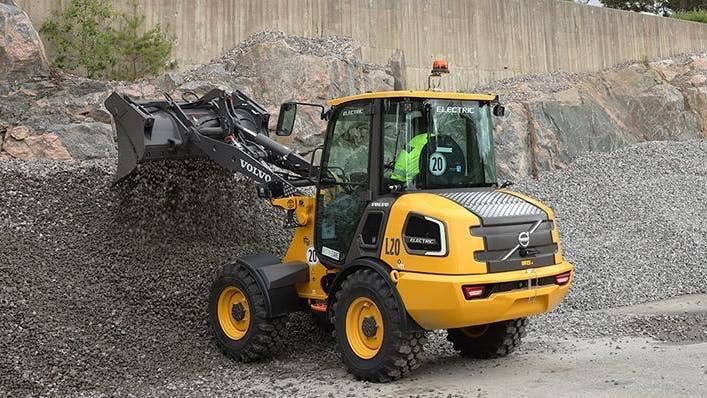What to Know About EV Maintenance
One of the selling points of EVs is their relative lack of maintenance compared to off-road machinery and on-road vehicles with internal combustion engines (ICE).
Whether you see a major role in your fleet for EVs or not, their day is coming, be it by mandate, market acceptance, or the removal of technological barriers like battery size and capacities. It will probably be a combination of these factors.
Sooner rather than later, managers should begin to prepare their techs and shops to maintain EVs.
Electric construction machinery and on-road EVs have some key differences for maintenance management; some obvious, some not so obvious.
Unlike ICE counterparts, when they are not working, they shut off completely. Without idling, there is no depletion of diesel or DEF, or materials to be regenerated or cleaned out of emissions-related filters. In fact, there is only hydraulic oil and grease to be concerned about--and voltage.
"Electrical components are sealed and guarded, and technicians should be trained to properly disconnect the high-voltage power to any parts before they’re removed and replaced," says Lars Arnold, electromobility product manager, Volvo Construction Equipment. "Volvo CE, for example, has very stringent training and qualification requirements to certify technicians to work on electric machines, whether it be the electrical or non-electrical components.
"Because we’re talking about machines using electricity, much of the additional training needed for technicians will be about safety," Arnold says. "Some of the concepts they’ll need to learn include how an AC 3-phase motor functions; Ohm’s law, which is the relationship between voltage, current, and resistance in a circuit; Fleming’s left- and right-hand motor and generator rules; and the effect that current flow has on a magnetic field. Other topics unique to electric heavy equipment are inverter function, onboard charging system operation, and how a lithium-ion battery works."
Read also: North Carolina College Developing State’s First Two-Year EV Training Program
For the most part, the lithium-ion battery, AC to DC power converter, inverter, and charging plug will just need visual inspections. Arnold recommends that any components found not working should be replaced, not repaired.
"Charging systems may also need service at times," Arnold says. "That would be dictated by the manufacturer of those items, which will typically be different than the machine manufacturer."
Volvo and others have maintained that the lifetime of battery-electric components should be equal to or better than that of the diesel engine on a conventional machine. "We conservatively estimate that users will see a 35% savings in maintenance cost and time over the life of the machines we offer," Arnold says. Volvo CE offers a six-year warranty for electric components.
The U.S. Department of Energy's (DOE) Alternative Fuels Center, a good source for learning the government's suggested guidelines for an EV transition, addresses on-road EV maintenance in particular. It points out that the battery, motor, and associated electronics require little to no regular maintenance, and there are fewer fluids, such as engine oil, that require regular maintenance.
Brake wear is also significantly reduced due to regenerative braking, and there are far fewer moving parts relative to a conventional fuel engine.
The advanced batteries used in these vehicles have a limited number of charging cycles (the number of times the battery can be charged and discharged, also called "cycle life"). Check with the dealer about battery life and warranties and consider the manufacturer's battery recycling policy. Some automotive battery systems use liquid coolant to maintain safe operating temperatures. These systems may require regular checks. Managers should check with the dealership or refer to the owner's manual for more information.
Read also: EV Tires Slow to Develop for Construction Equipment
The batteries in electric-drive vehicles are generally designed to last for the expected lifetime of the vehicle. Like the engines in conventional vehicles, the advanced batteries in EVs are designed for extended life but will wear out eventually. While comprehensive data on EV battery failures is not available, many manufacturers offer 8-year/100,000-mile warranties for their EV batteries, the DOE says.
Manufacturers typically do not publish pricing for replacement batteries, but if the battery does need to be replaced outside the warranty, it is expected to be a significant expense. However, battery prices are expected to decline as technology improves and production volumes increase. Batteries are also expected to be lighter in weight.
All-electric vehicles (as well as plug-in hybrid EVs and hybrid EVs) have high-voltage electrical systems that typically range from 400 to 1,000 volts, the DOE says. Their battery packs meet testing standards that subject batteries to conditions such as overcharge, vibration, extreme temperatures, short circuit, humidity, fire, collision, and water immersion.
Manufacturers design these vehicles with insulated high-voltage lines, and light-duty vehicles are required to have safety features that can deactivate or isolate the electrical system when they detect a collision or short circuit. All-electric vehicles tend to have a lower center of gravity than conventional vehicles, making them more stable and less likely to roll over.
Read also: Rowling: Another EV obstacle—tires
Because of today's heavy batteries, there are some concerns about on-road safety.
Ratchet + Wrench, a sibling publication to Construction Equipment covering automotive shops, recently published advice fleet and maintenance managers can use with EVs and electric equipment. Culled from automotive industry shop owners, industry and national safety organizations, it focuses on training and research.
Make sure all technicians who work on EVs and HEVs have completed comprehensive training and certification programs so they are aware of the range of possible hazards. Shop owners or managers also should undergo such training to be available to assist with diagnostics and repairs and answer questions as needed.
Emphasize the importance of reading manufacturers’ service information on the specific make, model, and year of a vehicle before starting a job. Those manuals will include instructions on how to properly follow safety procedures for a particular vehicle, which can vary based on type. For example, manufacturers have developed different mechanisms for disconnecting high-voltage batteries from a vehicle’s main electrical system, as well as color-coding systems to identify high-voltage cables (although those are typically orange or blue). Technicians should never rely on memory as they prepare to address a problem or handle a vehicle component, and if they aren’t sure about a step, they should consult with a manager.
Plan out a job in advance. A “figure it out along the way” approach to servicing EVs and HEVs doesn’t work well, because a technician could fail to have the right tools and safety equipment at the ready.
Eliminate the chance of a vehicle turning on accidentally during a job. Turn off the ignition, move key fobs out of the area and wait at least 15 minutes after a battery has been disconnected to begin work.
About the Author
Frank Raczon
Raczon’s writing career spans nearly 25 years, including magazine publishing and public relations work with some of the industry’s major equipment manufacturers. He has won numerous awards in his career, including nods from the Construction Writers Association, the Association of Equipment Manufacturers, and BtoB magazine. He is responsible for the magazine's Buying Files.




